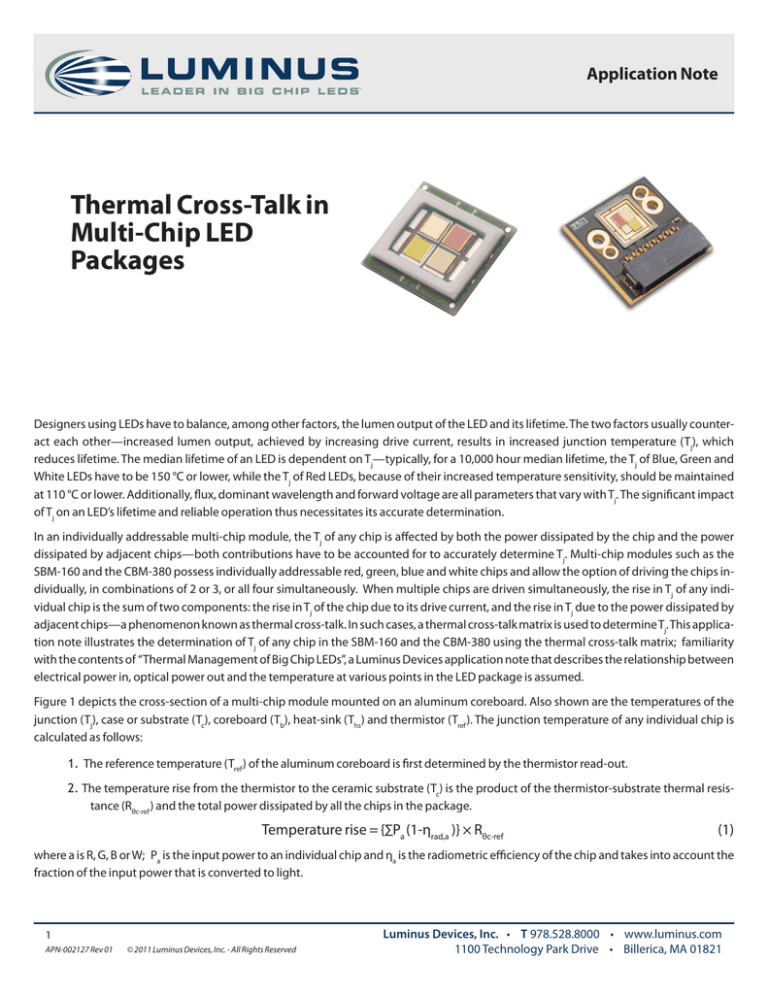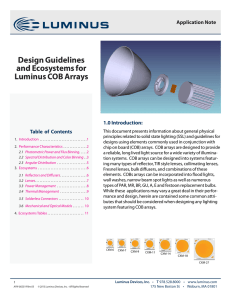
Application Note
Thermal Cross-Talk in
Multi-Chip LED
Packages
Designers using LEDs have to balance, among other factors, the lumen output of the LED and its lifetime. The two factors usually counteract each other—increased lumen output, achieved by increasing drive current, results in increased junction temperature (Tj), which
reduces lifetime. The median lifetime of an LED is dependent on Tj—typically, for a 10,000 hour median lifetime, the Tj of Blue, Green and
White LEDs have to be 150 °C or lower, while the Tj of Red LEDs, because of their increased temperature sensitivity, should be maintained
at 110 °C or lower. Additionally, flux, dominant wavelength and forward voltage are all parameters that vary with Tj. The significant impact
of Tj on an LED’s lifetime and reliable operation thus necessitates its accurate determination.
In an individually addressable multi-chip module, the Tj of any chip is affected by both the power dissipated by the chip and the power
dissipated by adjacent chips—both contributions have to be accounted for to accurately determine Tj. Multi-chip modules such as the
SBM-160 and the CBM-380 possess individually addressable red, green, blue and white chips and allow the option of driving the chips individually, in combinations of 2 or 3, or all four simultaneously. When multiple chips are driven simultaneously, the rise in Tj of any individual chip is the sum of two components: the rise in Tj of the chip due to its drive current, and the rise in Tj due to the power dissipated by
adjacent chips—a phenomenon known as thermal cross-talk. In such cases, a thermal cross-talk matrix is used to determine Tj. This application note illustrates the determination of Tj of any chip in the SBM-160 and the CBM-380 using the thermal cross-talk matrix; familiarity
with the contents of “Thermal Management of Big Chip LEDs”, a Luminus Devices application note that describes the relationship between
electrical power in, optical power out and the temperature at various points in the LED package is assumed.
Figure 1 depicts the cross-section of a multi-chip module mounted on an aluminum coreboard. Also shown are the temperatures of the
junction (Tj), case or substrate (Tc), coreboard (Tb), heat-sink (Ths) and thermistor (Tref ). The junction temperature of any individual chip is
calculated as follows:
1. The reference temperature (Tref ) of the aluminum coreboard is first determined by the thermistor read-out.
2. The temperature rise from the thermistor to the ceramic substrate (Tc) is the product of the thermistor-substrate thermal resistance (Rθc-ref ) and the total power dissipated by all the chips in the package.
Temperature rise = {∑Pa (1-ηrad,a )} × Rθc-ref
(1)
where a is R, G, B or W; Pa is the input power to an individual chip and ηa is the radiometric efficiency of the chip and takes into account the
fraction of the input power that is converted to light.
1
APN-002127 Rev 01
© 2011 Luminus Devices, Inc. - All Rights Reserved
Luminus Devices, Inc. • T 978.528.8000 • www.luminus.com
1100 Technology Park Drive • Billerica, MA 01821
ThermalBig
Cross-Talk-Application
Note
Testing
Chip LEDs- Application
Note
Window
Tj
Die Junction
Tc
Window Frame
Tb
Ceramic Substrate
Al Coreboard
Thermistor
Ths
Tref
Heat Sink
Ths definition = 3 mm from core-board
Figure 1: Cross-Section of a Multi-Chip Module
Note that, while Figure 1 shows a typical arrangement, the choice of coreboard, the location of the thermistor, and the solder used to mount
the SBM-160 to the coreboard lies with the user, thus Rθc-ref is a reflection of those choices and can differ from the value listed in the SBM-160
data-sheet.
3.The temperature rise from the substrate to the junction of a chip is given by the product of two matrices as shown below—the
thermal cross-talk matrix and the power dissipated by the chip. Tj rise for the SBM-160 is given by:
ΔTjR 1.486 0.019 0.003 0.019
PR × 1-η rad, R ΔTjG
0.018 1.462 0.018 0.003
PR × 1-η rad, G
ΔTjB
0.003 0.018 1.462 0.018
PR × 1-η rad, B
ΔTjW
0.018 0.003 0.019 1.486
PR × 1-η rad, W
=
Actual junction temperature (Tja) of any chip in the SBM-160 is the sum of reference temperature (Tref), temperature gradient from reference
to case {∑Pa (1-ηrad,a )} × Rθc-ref and temperature rise from case to junction (ΔTja).
Tja= T ref + {∑Pa (1-ηrad,a )} × Rθc-ref + ΔTja
(2)
where a is R, G, B or W; Pa is the input power to an individual chip and ηa is the radiometric efficiency of the chip.
A similar approach can be followed to determine the Tj of any chip in the CBM-380. One of the principal differences between the SBM-160
and CBM-380 lies in packaging: the SBM-160 is a surface mount LED and the CBM-380 is a chip-on board LED. While the SBM-160 must be
mounted to the user’s Printed Circuit Board and requires that the thermistor-case thermal resistance be subsequently characterized; the
CBM-380 includes an on-board thermistor with the junction-thermistor thermal resistance of each die already characterized. The thermal
cross-talk matrix, then, is constructed to give the Tj rise from the thermistor, as opposed to the Tj rise from the case for the SBM-160. Tj rise
for the CBM-380 is given by:
ΔTjR ΔTjG
ΔTjB
ΔTjW
=
2
APN-002127 Rev 01
© 2011 Luminus Devices, Inc. - All Rights Reserved
0.635
0.169
0.158
0.116
0.156
0.595
0.094
0.130
0.158
0.103
1.113
0.183
0.091
0.126
0.158
0.742
PR × 1-η rad, R
PR × 1-η rad, G
PR × 1-η rad, B
PR × 1-η rad, W
Luminus Devices, Inc. • T 978.528.8000 • www.luminus.com
1100 Technology Park Drive • Billerica, MA 01821
ThermalBig
Cross-Talk-Application
Note
Testing
Chip LEDs- Application
Note
Actual junction temperature (Tja) of any chip in the CBM-380 is the sum of reference temperature (Tref ) and temperature rise from reference
to junction (ΔTja).
Tja= {∑Pa (1-ηrad,a )} × Rθc-ref + ΔTja
(3)
where a is R, G, B or W; Pa is the input power to chip and ηa is the radiometric efficiency of the chip.
3
APN-002127 Rev 01
© 2011 Luminus Devices, Inc. - All Rights Reserved
Luminus Devices, Inc. • T 978.528.8000 • www.luminus.com
1100 Technology Park Drive • Billerica, MA 01821
Testing Big Chip LEDs- Application Note
The products, their specifications and other information appearing in this document are subject to change by Luminus Devices without notice. Luminus
Devices assumes no liability for errors that may appear in this document, and no liability otherwise arising from the application or use of the product or
information contained herein. None of the information provided herein should be considered to be a representation of the fitness or suitability of the
product for any particular application or as any other form of warranty. Luminus Devices’ product warranties are limited to only such warranties as
accompany a purchase contract or purchase order for such products. Nothing herein is to be construed as constituting an additional warranty. No
information contained in this publication may be considered as a waiver by Luminus Devices of any intellectual property rights that Luminus Devices
may have in such information. Big Chip LEDs™ is a registered trademark of Luminus Devices, Inc., all rights reserved.
This product is protected by U.S. Patents 6,831,302; 7,074,631; 7,083,993; 7,084,434; 7,098,589; 7,105,861; 7,138,666; 7,166,870; 7,166,871; 7,170,100;
7,196,354; 7,211,831; 7,262,550; 7,274,043; 7,301,271; 7,341,880; 7,344,903; 7,345,416; 7,348,603; 7,388,233; 7,391,059 Patents Pending in the U.S. and
other countries.
4
APN-002127 Rev 01
© 2011 Luminus Devices, Inc. - All Rights Reserved
Luminus Devices, Inc. • T 978.528.8000 • www.luminus.com
1100 Technology Park Drive • Billerica, MA 01821




